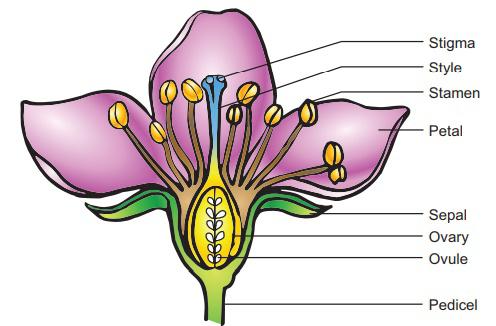MCQ ON GYNOECIUM/ GYNOECIUM class 11 for NEET | GYNOECIUM class 11| MCQ GYNOECIUM with Answer | Check the below NCERT MCQ question for class 11Biology based on the with Answers.
MCQ on GYNOECIUM class 11Biology with answers were prepared based on the latest pattern.We have provided class 11 Biology MCQs question with Answers to help students understand the concept very well.

MCQ ON GYNOECIUM/ GYNOECIUM class 11 for NEET
MCQ ON GYNOECIUM is useful for NEET / CSIR / UGC / CBSE / ICSE / AIIMS / EXAM / AFMC EXAM / STATE LEVEL MEDICAL EXAM/ KVS PGT BIOLOGY / NVS PGT BIOLOGY EXAM 2023-2024 ,2025
INTRODUCTION:-
GYNOECIUM :-
Gynosium is the female reproductive part of the flower and is made of one more carpels.
A carpel consist of three parts namely stigma style and ovary.
Ovary is the enlarged basal part , on which lies the elongated tube, the style .
The style connects the ovary to the stigma.
Stigma is the usually tip of the style and is the receptive surface for pollen grains .
Each ovary bears one or more ovules attached to a flattened, cushion like placenta.
When more than one carpel is present , there may be free as in Lotus and rose and are called Apocarpous.
They are termed as Syncarpous when carpels are fused as in mustard and tomato.
After fertilisation , the ovules develop into seeds and the ovary matures into a fruit.
Androecium is composed of stamens.Each stamens which represents the male reproductive organ consists of a stalk or a filament and an anther.
Each anther is usually bilobed and each lobe has two chambers , the pollen sacs. The pollen grains are produced in pollen-sacs.A sterile stamen is staminode .
Stamens of flower may be united with other members such as petals or among themselves .
When stamens are attached to the petals , they are epipetalous as in brinjal
Epiphyllous when attached to the perianth as in the flower of Lily.
The stamens in a flower may either remain free ( polyandrous) or may be united in varying degrees .
The stamens may be united into bunch or one bundle ( monoadelphous) as in China rose or two bundles (diadelphous) as in pea , or into more than two bundles (polydelphous) as in citrus.
There may be variations in the length of filaments within a flower as in salvia and mustard.
MCQ ON GYNOECIUM class 11 for NEET/KVS PGT BIOLOGY / NVS PGT BIOLOGY EXAM 2023-2024,2025
1. The female reproductive part of the flower.
(a) stamens
(b) andriecium
(c) gynoecium
(d) valvate
Ans (c) gynoecium
2. Gynoecium is made up of one or more
(a) carpels
(b) stamen
(c) imbricate and vexillary
(d) petals
Ans. (a) carpels
3.A carpels consists of
(a) stigma
(b) style
(c) ovary
(d) all the above
Ans. (d) all the above
4. Which is the enlarged basal part of gynoecium?
(a) style
(b) stigma
(c) ovary
(d) all the above
Ans.(c) ovary
5. Which connects the ovary to the stigma ?
(a) style
(b) staminode
(c) ovule
(d) epipetalous
Ans.(a) style
6. The receptive surface for pollen grains
(a) stigma
(b) epipetalous
(c) epiphyllous
(d) ovary
Ans.(a) stigma
7.Each ovary bears one or more ovules attached to the flattened , cushion like
(a) staminode
(b) epipetalous
(c) epiphyllous
(d) placenta
Ans.(d) placenta
8.When more than one carpel, there may be free and are called
(a) apocarpous
(b) syncarpous
(c) epiphyllous
(d) marginal
Ans.(a) apocarpous
9. Apocarpous found in
(a) lotus
(b) rose
(c) both a and b
(d) none of the above
Ans. (c) both a and b
10. When carpels are fused
(a) Apocarpous
(b) Syncarpous
(c) both a and b
(d) china rose and cotton
Ans. (b) Syncarpous
11.Syncarpous found in
(a) mustard
(b) tomato
(c) both a and b
(d) cotton
Ans.(c) both a and b
12. After fertilisation, the ovule develops into
a) seed
b) fruit
c) flower
(d) all the above
Ans . (a) seed
13. After fertilisation the ovary matures into
(a) seed
(b) fruits
(c) pea
(d) china rose
Ans.(b) fruit
14. Tip of the style found
(a) stigma
(b) monoadelphous
(c) polydelphous
(d) ovum
Ans. (a) stigma
ALSO READ:-
● YOU CAN WATCH BIOLOGY SIR Youtube channel
15. Ovary is the enlarged basal part on which lies the elongated tube
(a) style
(b) stigma
(c) cotton
(d) china rose
Ans.(a) style
16. Which is not Apocarpous ?
(a) lotus
(b) rose
(c) mustard
(d) all
Ans.(c) mustard







Leave a Comment